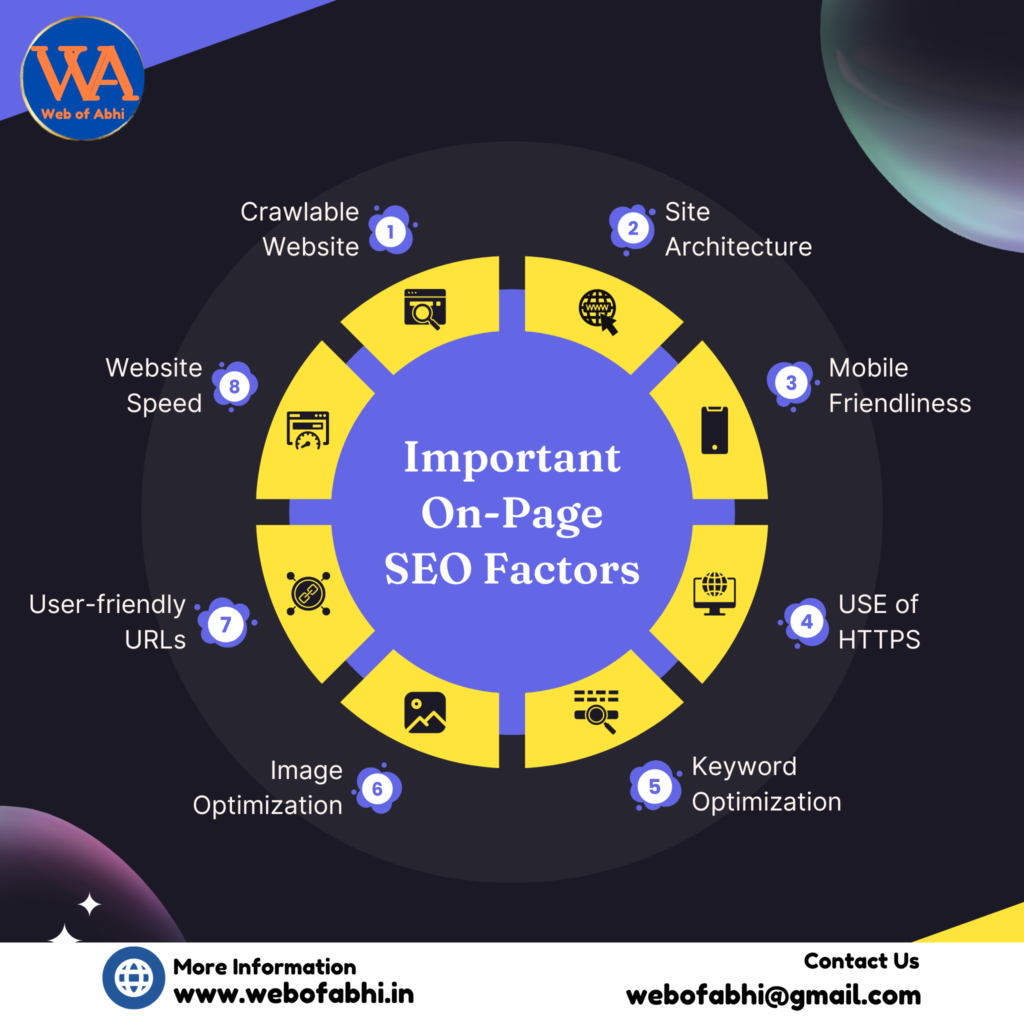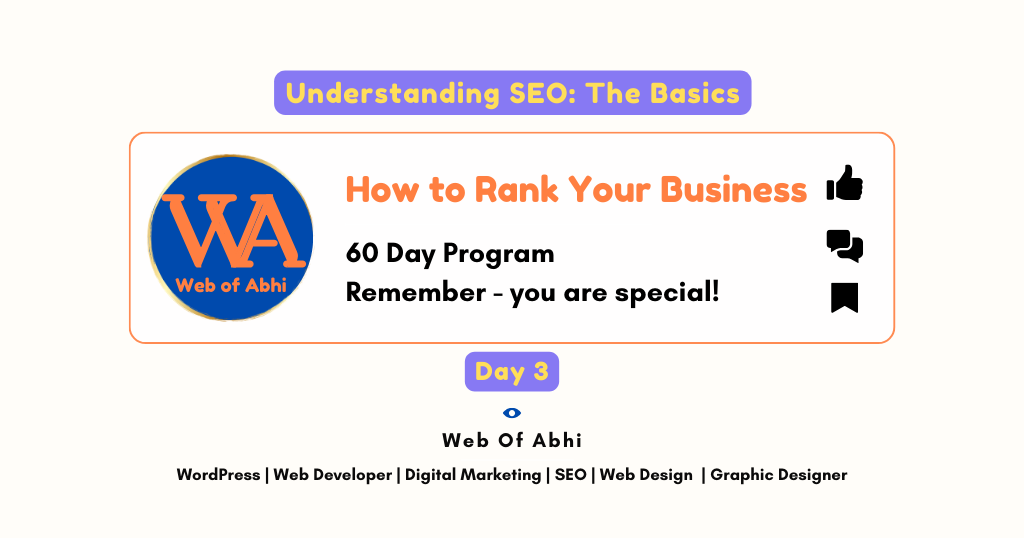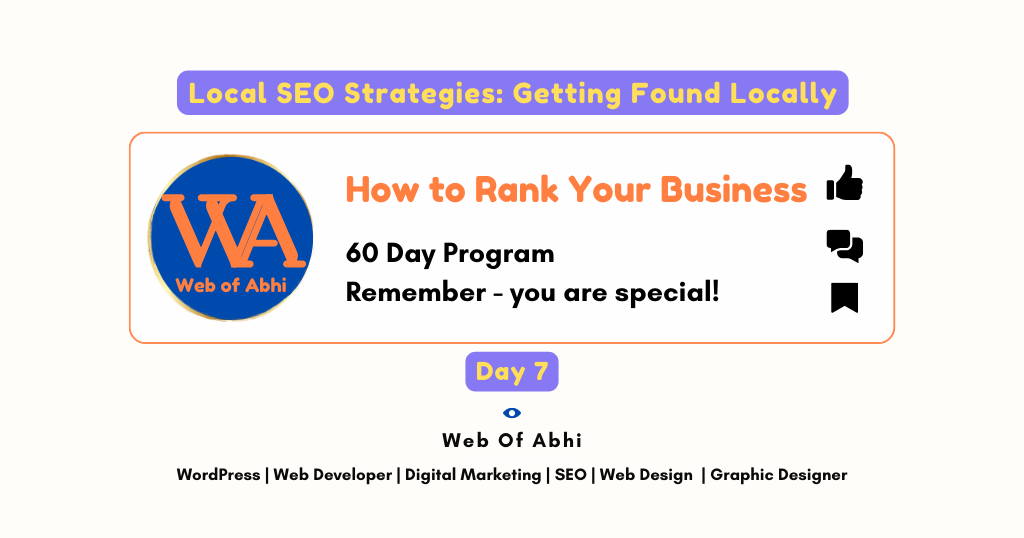How to Rank Your Business Series – Day 05
On-page SEO is the practice of optimizing individual web pages to rank higher and earn more relevant traffic in search engines. By optimizing various on-page elements, you can improve your website’s visibility, relevance, and user experience. In this guide, we’ll delve into the essentials of on-page SEO, covering key elements and best practices for optimizing your website content. Building on our previous discussions on keyword research, we’ll explore how to incorporate target keywords effectively and enhance your on-page optimization efforts.
Let’s Understand On-Page SEO
Understanding On-Page SEO
On-page SEO refers to the optimization of individual web pages to improve their search engine rankings and enhance user experience. It involves optimizing various elements on a webpage, such as content, HTML code, meta tags, and internal links, to make them more relevant and valuable to both users and search engines.
On-page SEO plays a crucial role in overall SEO strategy by helping search engines understand the content and relevance of a webpage, which ultimately impacts its visibility in search results. Additionally, by optimizing on-page elements, such as title tags, meta descriptions, and heading tags, websites can attract more qualified traffic, improve click-through rates, and enhance user engagement, resulting in a better overall website performance and user experience.
Key On-Page SEO Elements
- Title Tags: Title tags are HTML elements that specify the title of a webpage. They appear as the clickable headline in search engine results and are crucial for both SEO and user experience. Title tags should accurately describe the content of the page while incorporating relevant keywords to improve search engine visibility.
- Meta Descriptions: Meta descriptions are brief summaries of a webpage’s content that appear below the title tag in search engine results. While they don’t directly impact rankings, well-crafted meta descriptions can entice users to click on your link by providing a compelling preview of the page’s content. It’s essential to write unique, descriptive meta descriptions that encourage clicks and accurately reflect the page’s content.
- Heading Tags: Heading tags (e.g., H1, H2, H3) are HTML elements used to structure the content of a webpage. They help organize the content into sections and provide hierarchical significance to different parts of the page. Proper use of heading tags not only improves readability and user experience but also signals to search engines the important topics and keywords on the page.
- URL Structure: URL structure refers to the format and organization of the webpage’s URL. A clean, descriptive URL that includes relevant keywords can enhance both user experience and search engine visibility. It’s recommended to use short, readable URLs that accurately reflect the content of the page and avoid unnecessary parameters or characters.
- Content Optimization: Content optimization involves creating high-quality, relevant content that is valuable to users and optimized for search engines. This includes incorporating target keywords naturally throughout the content, addressing user intent, providing comprehensive information, and ensuring readability and engagement. Well-optimized content is essential for ranking well in search results and attracting organic traffic.
- Image Optimization: Image optimization involves optimizing images on a webpage to improve load times, accessibility, and search engine visibility. This includes using descriptive filenames and alt tags that include relevant keywords, optimizing image sizes for faster loading, and ensuring images are properly formatted and compressed.
- Internal Linking: Internal linking refers to the practice of linking to other pages within the same website. It helps search engines discover and index content, establishes a hierarchy and relationship between pages, and distributes link equity throughout the site. Internal links also improve navigation and user experience by guiding users to related content and encouraging further exploration of the website.

Incorporating Keywords Effectively
- Keyword Placement: Keyword placement refers to the strategic positioning of target keywords within the content of a webpage to improve its relevance and visibility in search engine results. Key areas for keyword placement include the title tag, meta description, headings, body content, and URL. By placing keywords naturally and strategically throughout the content, website owners can signal to search engines the topic and relevance of the page, ultimately improving its ranking potential.
- Keyword Density: Keyword density is the percentage of times a target keyword or phrase appears within the content of a webpage compared to the total number of words on that page. While there is no exact formula for ideal keyword density, it’s generally recommended to use keywords naturally and avoid “keyword stuffing,” which can be perceived as spammy and may result in penalties from search engines. Instead, focus on creating high-quality, relevant content that addresses user intent and incorporates keywords in a natural and meaningful way.
- Latent Semantic Indexing (LSI): Latent Semantic Indexing (LSI) is a concept used by search engines to analyze the relationships between terms and concepts within a piece of content. It allows search engines to understand the context and relevance of a webpage’s content beyond just the presence of specific keywords. LSI keywords are terms that are semantically related to the main keyword or topic of a page. By incorporating LSI keywords naturally into the content, website owners can improve its relevance, comprehensiveness, and ranking potential. LSI helps search engines understand the nuances of language and user intent, resulting in more accurate and relevant search results.
What is Technical On-Page Optimization?
- Mobile-Friendliness: Mobile-friendliness refers to the design and functionality of a website to ensure optimal viewing and usability across various mobile devices, such as smartphones and tablets. With the increasing use of mobile devices for internet browsing, Google considers mobile-friendliness as a critical ranking factor. Websites that are mobile-friendly are more likely to rank higher in mobile search results and provide a better user experience. Mobile-friendly design principles include responsive design, which adjusts the layout and content of a webpage based on the screen size and orientation of the device, as well as mobile-friendly navigation and touch-friendly elements.
- Page Speed: Page speed refers to the time it takes for a webpage to load completely in a user’s web browser. It’s a crucial factor for both user experience and search engine optimization. Websites with fast-loading pages tend to have lower bounce rates, higher engagement, and better conversion rates. Google considers page speed as a ranking factor, especially for mobile search results. To improve page speed, website owners can optimize images and multimedia content, leverage browser caching, minify CSS and JavaScript files, enable compression, and use content delivery networks (CDNs) to deliver content more efficiently.
- Schema Markup: Schema markup is a structured data markup language that allows website owners to provide additional context and information about their webpages to search engines. It helps search engines understand the content and context of a webpage better, which can lead to enhanced search results known as rich snippets or rich search results. Schema markup can be used to mark up various types of content, such as articles, events, products, reviews, and more. By implementing schema markup, website owners can improve the visibility and click-through rates of their webpages in search results and provide users with more relevant and informative search listings.
Optimizing for User Experience
- Readability: Readability refers to how easily and comfortably users can read and comprehend the content of a webpage. It encompasses factors such as font size, font style, line spacing, paragraph length, and overall layout. Websites with good readability are more engaging and accessible to users, leading to higher levels of user satisfaction and retention. To improve readability, website owners should use legible fonts, maintain consistent typography, break up text into smaller chunks with descriptive headings and bullet points, and ensure sufficient contrast between text and background colors.
- User Intent: User intent, also known as search intent, refers to the underlying motivation or goal behind a user’s search query. Understanding user intent is crucial for creating relevant and valuable content that meets the needs and expectations of users. There are generally four main types of user intent: informational (seeking information or answers), navigational (looking for a specific website or resource), transactional (seeking to complete a purchase or transaction), and commercial investigation (researching products or services before making a decision). By aligning content with user intent and addressing the specific needs and questions of users, website owners can enhance user experience, increase engagement, and drive conversions.
Testing and Iteration
- A/B Testing: A/B testing, also known as split testing, is a method used to compare two versions of a webpage or element to determine which one performs better in terms of achieving a specific goal, such as click-through rates, conversions, or engagement. In the context of on-page SEO, A/B testing can be used to test different variations of elements such as title tags, meta descriptions, headings, content, and call-to-action buttons to see which version yields better results in search engine rankings and user engagement. By systematically testing different elements and analyzing the results, website owners can identify areas for improvement and optimize their on-page SEO strategy for better performance.
- Continuous Improvement: Continuous improvement, also known as iterative optimization, involves an ongoing process of making incremental changes and refinements to a website’s on-page elements based on data-driven insights and feedback. It emphasizes the importance of continually monitoring performance metrics, analyzing user behavior, and iterating on strategies to enhance SEO effectiveness and user experience over time. Continuous improvement involves tasks such as monitoring keyword rankings, tracking traffic and engagement metrics, conducting regular audits of on-page elements, implementing best practices and industry trends, and staying informed about algorithm updates and changes in user behavior. By embracing a mindset of continuous improvement, website owners can adapt to evolving search engine algorithms, user preferences, and industry trends, ultimately driving long-term success and competitiveness in the online marketplace.
On-page SEO is a fundamental aspect of optimizing your website for better search engine rankings and user experience. By implementing the on-page optimization essentials outlined in this guide and incorporating target keywords effectively, you can enhance your website’s visibility, relevance, and ultimately, drive more organic traffic and conversions.
Stay tuned for more insights on ranking your business in the digital landscape.
AR
Owner of Web of Abhi – Online Business Solution CompanyWeb Developer | WordPress | SEO | Digital Marketing | Graphic Designer | Web Design



